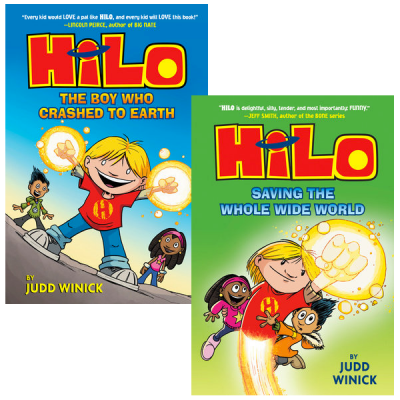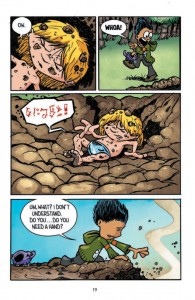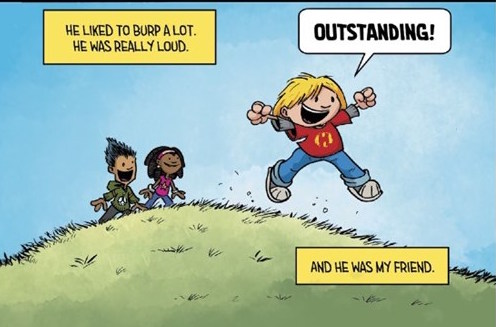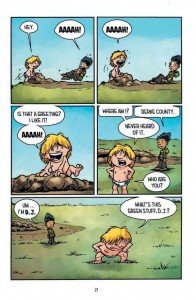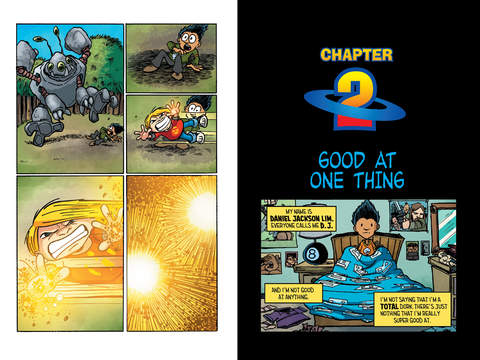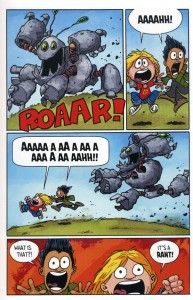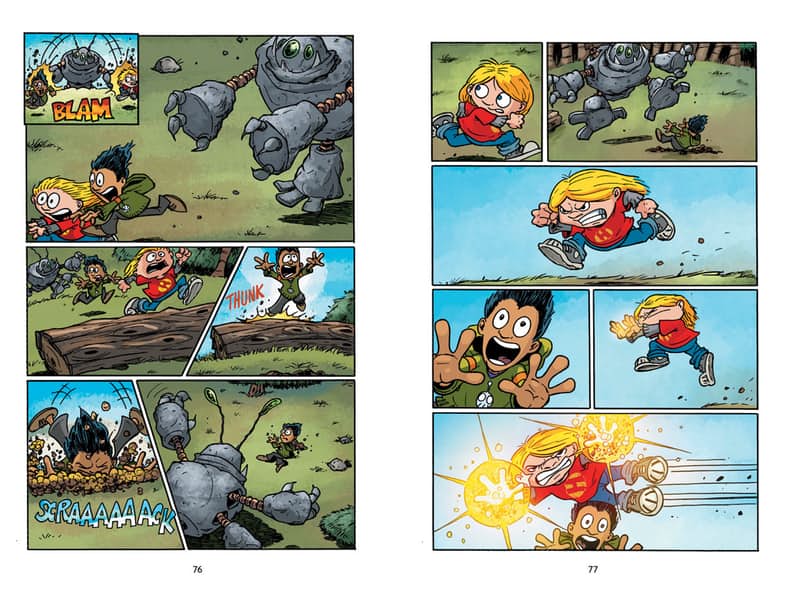Welcome to Using Graphic Novels in Education, an ongoing feature from CBLDF that is designed to allay confusion around the content of graphic novels and to help parents and teachers raise readers. In this column, we examine graphic novels, including those that have been targeted by censors, and provide teaching and discussion suggestions for the use of such books in classrooms.
This post takes a closer look at HiLo series by Judd Winick
Table of Contents
- OVERVIEW
- SERIES SUMMARY
- TEACHING/DISCUSSION SUGGESTIONS
- COMMON CORE STATE STANDARDS (CCSS)
- ADDITIONAL RESOURCES
OVERVIEW
HiLo is a wonderful series about JD Lim, an average boy in a family of superstars who thinks he’s only great at one thing — being Gina’s friend. But Gina moves away and DJ is on his own. Until one day, something shoots down from the sky and in the crater, DJ finds HiLo, a boy in silver underwear. From that moment on, DJ is good at two things: being friends with both Gina (who moves back) and HiLo. The problem is that HiLo doesn’t remember much about his past. He doesn’t remember where he’s from or why he’s come to Earth. And he has no idea why he’s wearing silver underpants, although he thinks they’re really cool. Together, HiLo, DJ, and Gina start piecing the fragments of HiLo’s memory together as strange robots continue to collide with Earth and the trio of friends bravely save the day. While a joy for all readers, the publisher recommends HiLo for ages 8-12.
HiLo received starred reviews from Kirkus Reviews, School Library Journal, and Bulletin of the Center for Children’s Books. It has also been on the New York Times Bestseller List.
There is a wonderful rhythm to Winick’s storytelling that makes the series a blast to read, and the vibrant color just adds to the pleasure. What is so compelling about this series, aside from the bold art and humor, is that with each page and installment we learn more about DJ, Gina, and HiLo through the combination of text, art and page/panel design. We also grapple with deeper issues of facing responsibilities, facing painful truths, and determining right from wrong as HiLo wrestles with his nemesis Razorwork and the role they each play in protecting humans versus protecting their fellow robots from “evil.”
This series is loaded with jokes, action, giant robots, and to coin HiLo, this series is truly “OUTSTANDING!”
HiLo is a wonderful addition to any elementary school classroom and library for several reasons. First, Winick unabashedly has fun with language, humor, and word play and we can’t help but be swept up with the fun and energy he creates. Further, while these characters are in some ways larger than life, they are also very real. They each have flaws that they wrestle with as they learn to cooperate and rely on the others’ strengths to get them through their challenges and doubts. As a result this is incredibly empowering. Third, this series provides wonderful lessons on character development while dealing with themes of diversity, individuality, and tolerance in a different, refreshing manner. Finally, we have Winick’s messages, which ever so subtly and humorously teach us to recognize good intentions and the power of family and true friendship.
Themes throughout this series (to date), include:
- The power of friendship
- Learning how to face fears and responsibilities
- Different ways one finds courage
- The powers and perils of large and small families
- Discovering and embracing who you really are
- Managing bullies
- Managing being different and embracing who you are
NOTE: There are six volumes to this series.
HiLo is as empowering as it is fun. We meet DJ, who doesn’t think he’s good at anything except being a friend, and we find that it is DJ who really holds this group together. Then we meet HiLo, who can’t remember much about his past or why he’s here on Earth, but he is full of life and fun and humor and can memorize the encyclopedia in a matter of minutes. Not wanting to be far from DJ, HiLo creatively enrolls himself in school (think rogue raccoons), and when out of school, HiLo, Gina, and DJ, pretty much protect Earth from robots that keep falling from the sky. As HiLo wrestles with his unknown past or purpose, DJ wrestles with protecting HiLo and Gina, who moved back to Berke County from the big city and must learn to adjust to a smaller school without an astronomy club that she loved as her mom pushes her to join the cheerleaders like her sisters.
What makes these books so empowering is the way author and illustrator Judd Winick respectfully yet playfully incorporates concepts of diversity and special needs in a way that makes us all laugh and love the diverse characters in HiLo and DJ’s world. Best of all, HiLo shows how three very different spunky and independent characters — each trying to overcome their perceived weaknesses and social challenges — can embrace who they are while saving themselves, saving each other, and saving Earth.
The playfulness in this series is achieved through Winick’s wonderful use of the art, color and text. The word play, the silver underwear and knock-knock jokes, HiLo’s burps, and the wonderful faces and expressions (inspired and much like Calvin and Hobbes), and the wonderful rhythm and pace of the storytelling all contribute to the fun of this series.
SERIES SUMMARY
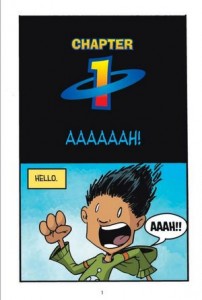
The first of the series, HiLo: The Boy Who Crashed to Earth opens with “AAAAAAH!” We see DJ running, saying hello, and screaming. And the pace never lets up. We soon realize DJ found HiLo, who hurtled to and crashed on Earth, and now he and DJ are running from a giant robot. At school, DJ finds Gina has returned to Berke County after moving away, and he and Gina help HiLo discover more about himself as they save Earth from free-falling alien robots. This first series ends with HiLo returning to the void, while leaving something behind, letting us know that the adventure and HiLo’s presence on Earth is far from over.
In the second book of the series, HiLo: Saving the Whole Wide World, HiLo returns along with a new crop of robots and friends. This time around though, HiLo has discovered knock-knock jokes which he relates intermittently while trying to return the robots to their worlds without hurting or destroying them. HiLo now has a home and a “guardian” — Uncle Trout — so adults don’t bother him. HiLo also has a new friend, Pollandra Pack Wallace Brimdale Kormimako of the mighty Furback Clan (Polly for short), a magical sorceress in training bound by honor to repay HiLo, who saved her life. They mark their bond of friendship by spitting, and DJ, Gina, HiLo, and Polly work together to rid Earth of a giant mutant chicken, Viking hippos, killer grass/vegetation bots, and a slew of good, bad, and indifferent robots. HiLo continues to find out more about himself and Gina and DJ realize the significant roles they play in all this as well. Here as in the first book, there’s a real cliffhanger and readers must wait for book three (HiLo: The Great Big Boom) which is scheduled for February, 2017.
TEACHING/DISCUSSION SUGGESTIONS:
Plot, Themes, and Values Related
- Have students talk about each of the stories and what they can learn from them.
- Winick notes that much of his inspiration came from Watterson’s Calvin and Hobbes. Compare these stories and strips toBill Watterson’s Calvin and Hobbes. Discuss how Calvin and HiLo are similar/different. How are HiLo’s sidekicks similar and different from Calvin’s Hobbes?
- Discuss how DJ, Gina, and HiLo (and later Polly) each play a role in saving Earth and in saving each other. Discuss each character’s strengths and weaknesses and how they work so successfully together to save the day.
- Discuss and evaluate the power of friendship, including over distance and over time (as is the case with DJ and Gina). How does time affect Gina and DJ’s relationship? How and why does their relationship stand the test of time?
- Discuss the powers and perils of living in small versus large families.
Critical Reading and Making Inferences
When reading these books, Winick makes wonderful inferences you may want to discuss with your students. For example:
- In HiLo: The Boy Who Crashed to Earth
- p. 9: DJ says, “I’m not good at anything. I’m not saying that I’m a TOTAL dork. There’s just nothing I’m really super good at.” Have students describe how DJ feels, then ask them to critically evaluate whether they think DJ has accurately described himself or not. Have them supply concrete examples that support their position.
- p. 12: DJ gets a box of colored elephants for him and Gina to play with. As a creative writing assignment, have students come up with their own ideas on what they and their best friends might do with those elephants.
- pp. 55-57: HiLo admits himself into DJ’s school and introduces himself to the class, at which point — after HiLo discusses some weird facts about Dallas, Texas — a classmate says to DJ, “Dude. Your pal is a real freak.” Have students analyze how DJ responds. Ask students to brainstorm what they would do if they were in DJ’s position.
- pp. 113-114: HiLo reflects to DJ, “You don’t like your family?” To Which DJ responds, “Of course I do. I just don’t like living with them sometimes.” Have students explain this distinction using examples from the book to support their impressions.
- In HiLo: Saving the Whole Wide World
- p. 23: Gina tells DJ that, “There’s lots of ways HiLo needs our help. But you don’t have to fight for him.” Have students brainstorm how DJ and Gina can and do help HiLo, and discuss why the one thing HiLo doesn’t need is for them to fight for him.
- pp. 19-23: This page is all about bullying. This is a great opportunity to discuss why kids pick on HiLo. Discuss why HiLo doesn’t fight back. Discuss why this scene is so difficult for DJ.
- p. 89: Gina tells DJ that, “Bad things are coming after [HiLo]. He’s dangerous. He doesn’t mean to be but he is.” Evaluate why Gina is concerned and in what ways HiLo may be inadvertently dangerous.
- p. 159: Before Polly leaves, she repays her debt to HiLo. She gives him a pouch with “The Orbs of Fellback,” telling HiLo to, “read the instructions within the pouch! You shall be kept a secret from this world!” As a discussion or creative writing assignment, have students brainstorm the origin of the Orbs of Fellback and how they might work to keep HiLo a secret.
Language, Literature, and Language Usage
- There is wonderful wordplay everywhere you look in this series. You may want to begin with Winick’s choice of names: Razorwark, Pollandra Pack Wallace Brimdale Kormimako of the mighty Furback Clan, Dr. Horizon, Rants, Uncle Trout, Beamer, Slobberbacks, Rapscallions, and many more.
- Discuss the development of HiLo’s humor from puns to knock-knock-jokes. Have kids create their own jokes using play on words.
- Identify examples of puns, homophones, hyperbole, alliteration, and onomatopoeia, idioms, and play on words. You may want students to work on teams to search for these gems and then create some of their own examples.
- Throughout the series, HiLo plays with and defines words. Have students chart the words HiLo finds and defines. Ask students to find some of their own “fun” words to define and use. What makes them fun? The sound? The definition?
Modes of Storytelling and Visual Literacy
In graphic novels, images are used to relay messages with and without accompanying text, adding additional dimension to the story. In HiLo, Winick brilliantly weaves story and background with image and emotions and insights, through text, image, and design. More specifically, the page and panel design, the use of fonts, and use of color are wonderfully engaging and help propel the reader through this warm, humorous, story. Furthermore, Winick is a master at using images and color for foreshadowing. Reading HiLo with your students allows you to analyze, discuss and learn how Winick uses page and panels, text and images to relay complex messages. For example:
- Winick is a master of facial expressions. Have students search for the ranges of HiLo’s moods and responses. Furthermore you may want to chart and note how these expressions are manipulated. For example, most of the time Winick keeps HiLo’s eyes white and black. Periodically, however, Winick will draw small black pupils for HiLo or in highly emotional panels, Winick draws full-color irises. You may want students to chart and evaluate when and why Winick has chosen to do this.
- Evaluate how Winick uses each character’s features to help describe them. For example, HiLo’s round face and often vacant eyes and yet expressive face, mouth, and body; or DJ’s pointed, hair.
- Discuss how Winick, using limited dialogue, limited narrative, expressive figures, bold color and chapter titles tells a detailed, engaging, and heartfelt story.
- Color plays a powerful role in this series. Discuss Winick’s use of color to relate and foreshadow new chapters, flashbacks, and fighting and action scenes.
Suggested Prose and Graphic Novel Pairings
For greater discussion on literary style, related themes, similar characters and/or content here are some book suggestions you may want to read and pair with HiLo:
- Big Nate by Lincoln Peirce: a comic strip that has spawned a graphic novel series that follows the adventures (and misadventures) of Nate Wright, a fun-loving, colorful sixth grader.
- Calvin and Hobbesby Bill Watterson: collections of comic strips about a rambunctious six year old with a vivid imagination and sharp intellect, much like HiLo.
- Ziti the Spacegirl by Ben Hatke: a graphic novel series about a girl named Zita who (much like HiLo) races into a parallel dimension to save her friend and ultimately save that world.
- Diary of a Wimpy Kid by Jeff Kinney: a series about a boy and his struggles in middle school.
- The Misadventures of Max Crumbly: Locker Hero by Rachel Renee Russell: about Max who’s about to start middle school who does his best besting bullies and assorted challenges.
- The Terrible Two by Mac Barnett and Dory John: about two middle school pranksters who must either compete for the title “best” or learn to cooperate and prank together to make school more tolerable.
COMMON CORE STATE STANDARDS (CCSS):
While this book is suggested for elementary school classrooms (grades 2-5), it can be incorporated into language arts and content-area classes for a variety of grades. I therefore will be using the Common Core Anchor Standards for College and Career Readiness for Reading, Writing, and Speaking and Listening. Reading HiLo and incorporating the teaching suggestions above promotes critical thinking and its graphic novel format provides verbal and visual story telling across subject areas while addressing multi-modal teaching. Here’s a more detailed look:
- Knowledge of Language: Apply knowledge of language to understand how language functions in different contexts, to make effective choices for meaning or style, to comprehend more fully when reading or listening.
- Vocabulary Acquisition and Use: Determine or clarify the meaning of unknown and multiple-meaning words and phrases by using context clues, analyzing meaningful word parts, and consulting general and specialized reference materials; demonstrate understanding of figurative language, word relationships, and nuances in word meaning; acquire and use accurately a range of general academic and domain-specific words and phrases sufficient for reading, writing, speaking and listening at the college and career readiness level.
- Key ideas and details: Reading closely to determine what the texts says explicitly and making logical inferences from it; citing specific textual evidence when writing or speaking to support conclusions drawn from the text; determining central ideas or themes and analyzing their development; summarizing the key supporting details and ideas; analyzing how and why individuals, events, or ideas develop and interact over the course of the text.
- Craft and structure: Interpreting words and phrases as they are used in a text, including determining technical, connotative, and figurative meanings and analyzing how specific word choices shape meaning or tone; analyzing the structure of texts, including how specific sentences, paragraphs and larger portions of the text relate to each other and the whole; Assessing how point of view or purpose shapes the content and style of a text.
- Integration of knowledge and ideas: Integrate and evaluate content presented in diverse media and formats, including visually…as well as in words; delineate and evaluate the argument and specific claims in a text, including the validity of the reasoning as well as the relevance and sufficiency of the evidence; analyze how two or more texts address similar themes or topics in order to build knowledge or to compare the approaches the authors take
- Range of reading and level of text complexity: Read and comprehend complex literary and informational texts independently and proficiently
- Comprehension and collaboration: Prepare for and participate effectively in a range of conversations and collaborations with diverse partners, building on others’ ideas and expressing their own clearly and persuasively; integrate and evaluate information presented in diverse media and formats, including visually, quantitatively and orally; evaluate a speaker’s point of view, reasoning, and use of evidence and rhetoric.
ADDITIONAL RESOURCES
- http://www.juddspillowfort.com/welcome/ — Winick’s web page , with news about the series, author tour information and assorted “This Makes Me Happy” cartoons by the author.
- https://www.rhcbooks.com/search?q=HILO&book=0&group=0&type=0 — Random House HiLo page, listing books with page previews and educators’ guides.
- For Author interviews, please visit: https://www.teachingbooks.net/tb.cgi?aid=26195
Meryl Jaffe, PhD teaches visual literacy and critical reading at Johns Hopkins University Center for Talented Youth Online Division and is the author of Raising a Reader! and Using Content-Area Graphic Texts for Learning. She used to encourage the “classics” to the exclusion comics, but with her kids’ intervention, Meryl has become an avid graphic novel fan. She now incorporates them in her work, believing that the educational process must reflect the imagination and intellectual flexibility it hopes to nurture. In this monthly feature, Meryl and CBLDF hope to empower educators and encourage an ongoing dialogue promoting kids’ right to read while utilizing the rich educational opportunities graphic novels have to offer. Please continue the dialogue with your own comments, teaching, reading, or discussion ideas at meryl.jaffe@cbldf.org and please visit Dr. Jaffe at http://www.departingthe text.blogspot.com.
We need your help to keep fighting for the right to read! Help support CBLDF’s important First Amendment work by visiting the Rewards Zone, making a donation, or becoming a member of CBLDF!
